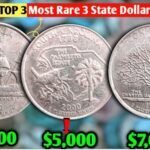Every so often, a story hits the headlines that makes people all over the world run to their coin jars and rummage through the spare change hiding under couch cushions. One of the biggest buzzworthy stories among collectors is the legendary $20 Million Wheat Penny. Just imagine: a single old penny, something you might overlook or even toss aside, could actually be worth enough to buy your dream home, luxury cars, and still leave you with millions to spare.
Sounds unbelievable? Well, for coin collectors, this is more than just wishful thinking. Rare coins, especially old American pennies, have long been the hidden gems of the numismatic world. And the famous $20 Million Wheat Penny stands out as one of the most jaw-dropping stories in coin collecting history. But what exactly is this penny, why is it worth so much, and how can you tell if you might own one? Let’s dig in.
What Is a Wheat Penny?
Before we break down the story of the $20 Million Wheat Penny, it’s important to understand what a Wheat Penny actually is. The Wheat Penny is the nickname given to the Lincoln cent that was minted by the United States from 1909 to 1958. It gets its name from the reverse side of the coin, which displays two simple wheat stalks surrounding the words “ONE CENT” and “UNITED STATES OF AMERICA.”
Designed by Victor David Brenner, the Wheat Penny was first issued in 1909 to honor the 100th anniversary of Abraham Lincoln’s birth. It was the first U.S. coin to feature the likeness of an actual person — before that, Liberty had been the only “face” on American coins. Millions of Wheat Pennies were minted over the years, and for decades, they were common in everyday transactions.
So what makes one simple penny worth $20 million? The answer lies in rare minting errors, extremely low mintages, and condition so pristine that collectors would pay any price to get their hands on it.
The $20 Million Wheat Penny: What Makes It So Special?
There are actually a few legendary Wheat Pennies that have fetched astronomical sums — or have the potential to do so. The $20 Million Wheat Penny is typically associated with the rarest variations, such as the 1943 Bronze Wheat Penny or the 1909-S VDB Wheat Penny.
1. The 1943 Bronze Wheat Penny
During World War II, copper was a critical war material, so the U.S. Mint decided to conserve it for ammunition by producing pennies out of zinc-coated steel instead. But due to a minting mishap, a handful of pennies were accidentally struck on leftover bronze planchets from 1942. It’s believed that fewer than 20 of these 1943 Bronze Wheat Pennies exist today, and they’re among the most valuable coins in American history.
One famously sold at auction for over $1 million, and experts say that the finest known example could be worth upwards of $20 million to the right buyer — giving rise to the legend of the $20 Million Wheat Penny.
2. The 1909-S VDB Wheat Penny
Another contender for the title of $20 Million Wheat Penny is the 1909-S VDB Wheat Penny. In 1909, the first year of issue for the Lincoln cent, designer Victor David Brenner’s initials “V.D.B.” were boldly placed on the reverse side of the coin, right at the bottom between the wheat stalks. Some critics thought the initials were too prominent, so they were removed partway through the minting run.
This means that pennies with the V.D.B. initials from the San Francisco Mint (“S” mint mark) are extremely rare — only about 484,000 were made. For comparison, modern pennies are minted by the billions. If you find a 1909-S VDB in pristine condition, especially in uncirculated or proof condition, it can easily command six figures, and the highest-grade known coins could approach the mythical $20 Million Wheat Penny mark in the future.
What Drives the Value of the $20 Million Wheat Penny?
Now you might be wondering, “How does a penny that’s over 70 years old become so valuable?” There are a few major factors that give these coins their status as a $20 Million Wheat Penny:
✅ Rarity: Coins like the 1943 Bronze Wheat Penny were never supposed to exist. Accidents in the minting process mean only a few survived.
✅ Historical Significance: Coins minted during important eras like World War II or the Lincoln cent’s debut year hold tremendous historical weight.
✅ Condition: A coin in average condition might be worth thousands — but if it’s uncirculated or graded at MS-65 or higher, its value skyrockets.
✅ Collector Demand: Some collectors and investors will pay nearly any price to own a unique piece of American history.
How to Check If You Have a $20 Million Wheat Penny
So, how do you find out if you’re holding one of these elusive treasures? Here are some steps to help you spot a potential $20 Million Wheat Penny:
1️⃣ Check the Date: The most valuable Wheat Pennies are typically from 1909, 1914, 1922, and especially 1943 if it’s not steel.
2️⃣ Use a Magnet: The 1943 Bronze Wheat Penny looks very similar to the common 1943 steel penny. A quick magnet test helps — steel pennies stick to a magnet, bronze pennies do not.
3️⃣ Inspect the Mint Mark: Look for the “S” under the date, which indicates it was minted in San Francisco — essential for the 1909-S VDB.
4️⃣ Look for the V.D.B. Initials: Flip the coin over and check the bottom between the wheat stalks for those tiny but valuable initials.
5️⃣ Check Condition: The fewer scratches and more original shine your penny has, the better. Serious collectors want coins in near-mint or mint state.
6️⃣ Get a Professional Opinion: If you think you have a candidate for a $20 Million Wheat Penny, never clean it (cleaning can ruin its value) — instead, have it authenticated by a reputable grading service like PCGS or NGC.
Other Rare Wheat Pennies to Look For
While the $20 Million Wheat Penny gets all the fame, other Wheat Pennies are worth hunting for too. Here are a few that regularly sell for impressive sums:
- 1914-D Wheat Penny: Only about 1.2 million were minted, making it a key rarity.
- 1922 No D Wheat Penny: A rare error coin struck in Denver with a missing mint mark.
- 1955 Doubled Die Wheat Penny: A famous error coin where the date and lettering appear doubled — these can bring thousands.
- 1931-S Wheat Penny: Minted during the Great Depression, only about 866,000 were produced.
Frequently Asked Questions About the $20 Million Wheat Penny
Q: Are all Wheat Pennies valuable?
A: No. Most Wheat Pennies are common and worth only a few cents over face value. It’s the rare dates, mint marks, and minting errors that make a $20 Million Wheat Penny so special.
Q: Where should I look for valuable pennies?
A: Old piggy banks, inherited coin jars, estate sales, garage sales, and even bank rolls can hide treasures. Many people have found rare coins in pocket change!
Q: Should I clean my Wheat Penny to make it look better?
A: Never clean a rare coin — cleaning can scratch the surface and dramatically reduce its value. Collectors want original patina and condition.
Q: How do I sell a rare penny?
A: If you think you have a $20 Million Wheat Penny, have it professionally graded and authenticated. Then, you can sell it through reputable auction houses or well-known coin dealers.
Final Thoughts: Is the $20 Million Wheat Penny Still Out There?
The idea that a simple penny could be worth more than most people earn in a lifetime is the stuff of dreams — yet for the world of coin collecting, it’s entirely possible. The $20 Million Wheat Penny is more than a legend; it’s a reminder that sometimes the rarest treasures hide in plain sight.
So, next time you’re about to drop that old penny into a tip jar or let it rattle around in your car’s cupholder, pause for a moment. Check the date. Look for mint marks. That humble cent could turn out to be the find of a lifetime.
After all, the next person to discover the legendary $20 Million Wheat Penny might just be you.
Some Important Link
| Download News APP | Click Here |
| WhatsApp Group | Click Here |
| Home Page | Click Here |












